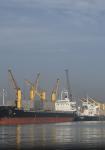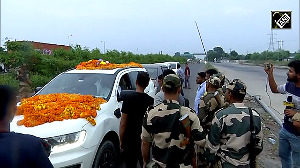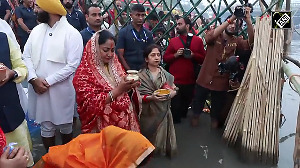
On November 21, 1963, a sleepy fishing village in Kerala surprised the National Aeronautics and Space Administration of the United States.
A group of Indian scientists, some of them trained at NASA, worked for six months at Thumba village near Kerala's capital, Thiruvananthapuram, to launch the country's first rocket, a small American Nike-Apache.
 NASA was surprised because this happened at a location that was truly rustic. The newly built rocket launching pad was set amidst coconut groves. A local Catholic church served as the main office for the scientists. The bishop's house was converted into a workshop. A cattle shed became the laboratory in which the scientists finetuned the rocket.
NASA was surprised because this happened at a location that was truly rustic. The newly built rocket launching pad was set amidst coconut groves. A local Catholic church served as the main office for the scientists. The bishop's house was converted into a workshop. A cattle shed became the laboratory in which the scientists finetuned the rocket.
This modest, but historic launch of India's first rocket excited other rocket-making nations. Over the next 12 years, the US, Britain, France and Russia helped India build, equip and launch more than 350 small rockets from Thumba.
Forty years later, Thumba is the hub of all space programmes helmed by the Indian Space Research Organisation. The Vikram Sarabhai Space Centre at Thumba has given India launch vehicles, geo-stationary satellites (used for telecommunications, television transmission and weather forecasting) and some of the finest remote sensing satellites.
On November 21, VSSC will re-enact the odyssey of the Indian space programme. The scientists here have pieced together 40 years of history, tracing the Indian space programme's growth from 'humble beginnings to great heights'.
"The success story of Indian space science is indeed fascinating. We are re-enacting those historic moments from how the journey began in this sleepy village and where it stands today," V P Balagangadharan, head of VSSC's technology transfer and industry co-ordination division, told rediff.com.
A Rohini 200 two-stage rocket carrying a meteorological payload will be launched from the Thumba station at 1530 IST on Friday to commemorate this milestone in India's space history. Besides, VSSC has also mounted an exhibition documening the beginning of the Indian space programme at Thumba.
![]()
Related Specials!
![]()
![]()
![]()
![]()
Those magnificent men and their flying machines![]()
'Kalam always took himself very seriously'![]()
![]()
![]()
The man who helmed India's nascent effort at conquering space was the late Dr Vikram Sarabhai, chairman of the erstwhile Indian National Committee for Space Research. Another scientist who worked with Dr Sarabhai to transform the village of Thumba into a centre of modern technology was Dr A P J Abdul Kalam, who took charge of India's presidency on July 25, 2002.
Last year, Kalam, now President of India, paid VSSC a nostalgic visit. "My real education was at VSSC," he had said then. "Here I was fortunate to be associated with three great human beings -- Dr Vikram Sarabhai, Professor Satish Dhawan and Dr Brahm Prakash."
 Why did Dr Sarabhai choose Thumba as the location for the country's first rocket launch? Scientists say it was because the village is near the magnetic equator (located just north of Thumba), making it the ideal location for scientists to conduct atmospheric research. In fact, Thumba's location at 8°32'34" N and 76°51'32" E is ideal for low-altitude, upper atmosphere and ionosphere studies.
Why did Dr Sarabhai choose Thumba as the location for the country's first rocket launch? Scientists say it was because the village is near the magnetic equator (located just north of Thumba), making it the ideal location for scientists to conduct atmospheric research. In fact, Thumba's location at 8°32'34" N and 76°51'32" E is ideal for low-altitude, upper atmosphere and ionosphere studies.
This has made Thumba an international launch site for sounding rockets. The normal launch area here covers about two square kilometres. The site has the capability to launch rockets up to 0.56 metres in diameter. The three launch pads at the Thumba Equatorial Rocket Launching Station have facilities for a variety of sounding rockets, including the French Centaure Dragon, the Indian Centaure and Rohini, Britain's Skua and Petrel, America's Nike-Apache, Nike-Tomahawk and Arcas and Russia's M-100.
Since the successful launch of the American Nike-Apache in 1963, scientists from France, Germany, Japan, Russia and Bulgaria have participated in numerous scientific experiments at Thumba.
According to Balagangadharan, VSSC, which is ISRO's largest centre today, provides the technology base for India's indigenous satellite launch vehicle development efforts. Besides, the Thumba station at the VSSC complex has been dedicated to the United Nations which funds many of the atmospheric research programmes here.
Even as the celebrations begin, Thumba is gearing up to launch a series of Rohini-200 rockets in the next five years, as part of the research programme in middle atmospheric dynamics.
ISRO undertook the Rohini programme after the successful conclusion of the India-Russian collaborative project under which M-100 rockets were launched from Thumba over 15 years. Among other things, VSSC scientists say the Rohini project will study the circulation changes in the break monsoon events.
"This programme will pave the way for a better understanding of middle atmospheric dynamics and behaviour of monsoon over the Indian subcontinent," a senior scientist at VSSC pointed out.
Image: Rahil Shaikh





